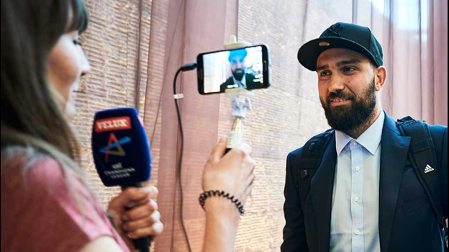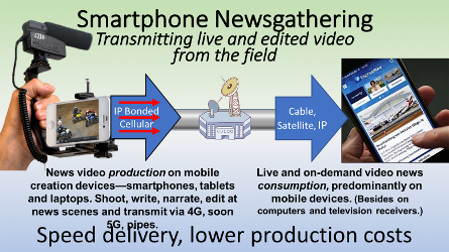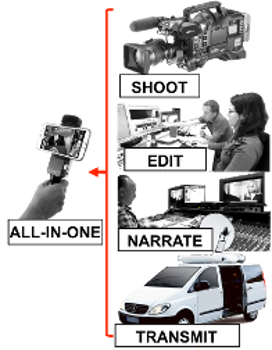Are Smartphones the Future of TV News?
Part I
Even though news consumers are increasingly turning from conventional television to the internet for news, the good news is they’re also demanding more video. That gives video-savvy broadcasters an edge, online, over their newspaper competitors, who are also attempting to cope with digital disruption. The bad news is that legacy television newsgathering gear and workflow—whose origins date back to the 1970s—are ill-suited for producing video for web consumption. The cost is too high and the process too slow. Consumers want their news fast, on-demand (not linear), often live, and on a variety of screen sizes, especially small, mobile screens.

A mobile journalist covers the 2016 EHF EUro Championships in Poland.
The high cost of outdated video news production is unsustainable, especially online where monetizing is tough, where broadcast news providers are competing with cute kitty YouTube video and where social media behemoths like Google and Facebook are sucking revenue out of the ad-o-sphere.
ENG HAS RUN ITS COURSE
Broadcasters are burdened with expensive electronic news gathering technology—camcorders, edit bays and live trucks; with inefficient workflows and with the nearly obsolete, linear news show format. (We don’t even know if many younger viewers are willing to sit through a newscast because they’re not watching TV at all.)
Television journalism quality, especially at the local level, has been sinking steadily in the United States due to a variety of factors, among them, FCC deregulation, cable, then internet competition, media consolidation, agenda-driven ownership like Sinclair Broadcasting and the Great Recession.
Low-quality newscasts are not exactly viewer magnets, thus also less attractive for advertisers. Seemingly never-ending layoffs result in fewer boots on the ground, that is far fewer reporters to ferret out actual news. (The U.S. Bureau of Labor Statistics forecasts reporter employment will yet continue to drop, another 9 percent over the next decade). Journalism by police scanner and press release is too common. Some TV news practices insult viewers’ intelligence, such as ubiquitous, black-hole (aka dog-lick) liveshots.
It appears that no U.S. television news outlet has gone all-in, online. They use internet delivery to supplement, not replace legacy delivery methods. And they still rely on ENG-based systems and methods that were developed when broadcast licenses were licenses to print money.
It does not take a crystal ball to see where we’re heading. Key words describe the trends: “online,” “IP,” “video,” “live,” “on-demand,” “mobile,” “small screens,” “fast,” and “low cost.” News dissemination will continue moving in that direction, slowly if television station owners continue to resist change; faster if enough of them manage to wake up and accept reality. (How fast can conventional ENG equipment can be pried from cold, dead hands?)
News outlets could afford to hire more reporters, give more raises and get by with less ad revenue if video production costs were substantially reduced. Cheaper, faster and better video news production, by itself, won’t guarantee online financial success or reverse the journalism quality freefall. But it could help.
LOWER COST, HIGHER SPEED SMARTPHONE NEWSGATHERING
"It's the economy, stupid!" is the phrase campaign strategist James Carville coined when suggesting key messages for Bill Clinton's successful 1992 presidential campaign.

"It's the economy, stupid!"
“It’s the workflow, stupid!” is good advice for any broadcast news manager trying to figure how to deploy new technologies, especially those involving video production and delivery. Technogies like smartphones replacing camcorders, edit bays and live trucks. And like IP delivery between the news scene and station, replacing microwave and satellite.
Many television stations already use smartphones and IP transmissions, but to a very limited extent. Perhaps worse, they impose outmoded ENG workflows onto smartphone newsgathering. That’s why, “it’s the workflow, stupid.”
One step at a time: First begin with a clean-sheet, internet-optimized workflow. Then add the tech to make it work. Just as the Bible advises against putting old wine in new bottles, new technologies should get optimal ways of using it.
Take, for example, this faster, cheaper web-delivery workflow:
Write, shoot, and edit (including voiceovers when applicable) in the field and transmit live reports and completed packages directly to the station, and on occasion even directly to news consumer’s viewing devices.
The key is in-field editing. Not at the station where editing usually takes place. In-station editing is the millstone hanging around legacy video production’s neck. It’s the main workflow obstacle blocking faster, cheaper production. Video editing for most stories needs to undergo a major shift to an earlier time and space, to the scenes where news is made.
The field-editing workflow element is not new to the television news industry. It’s been used, on occasion, ever since there were ENG vans with edit bays and microwave links to get edited video back to the station. Field editing is simply not a predominant practice.

One reason it’s been rare is that ENG and SNG trucks only appear at relatively few news scenes. Another is that with linear newscasts there’s usually time to return, write and edit. Few commercial station managers permit interrupting regular, paid programming for breaking news anyway. So, what’s the hurry?
The internet likes hurry. Online live and on-demand stories do not need to be delayed until there’s a regularly scheduled news show. Online news sites don’t have sponsored, non-news programming to interrupt.
What equipment and methods work best with that “new” workflow? Spoiler alert! It’s not ENG camcorders, edit bays and live trucks, nor is it field-to-station transmissions via microwave or satellite signals.
The best technology suited for that workflow is based on the device that’s right under the noses of television station owners and managers: the smartphone. It’s an off-the-shelf product that was not developed for mobile newsgathering as was the minicam in the 70s. Yet it’s a device the combines the shooting, editing and IP streaming of live and on-demand video in a single, inexpensive, easy-to-use, compact product. (Although smartphones are way cheaper than ENG tech, reporters still need to add rigs, lights, tripods, external mics and, when affordable, bonded cellular apps that boost bandwidth between the news scene and station.)

It takes more than the phones and related accessories to build a smartphone newsgathering infrastructure. It takes a blend of several concepts to make it work.
Key Video Newsgathering Infrastructure Components:
Smartphone newsgathering—Smartphones replace traditional ENG equipment like camcorders, edit bays and live trucks.
Video journalism—Video (film) journalists who report, shoot and edit replace most videographers and all video editors.
In-field editing—Most video is edited at or near the news scene and nearer the time of the news event. Field editing becomes the rule rather than the exception.
Field-to-newsroom (or direct to news consumer) streaming of live and edited video over IP—IP transmission replaces most if not all microwave and satellite field-to-station news video delivery. (Can be enhanced with bonded cellular technology.)
None of the four key components is new. What’s new is their being combined and prioritized over ENG. Smartphone should predominate until ENG is phased out completely.
Part II will look at smartphone journalism overseas and the impact of 5G.
Lynn Kenneth Packer is a freelance journalist and television news consultant. He has worked as reporter and a university adjunct instructor, and conducts newsgathering workshops.
Get the TV Tech Newsletter
The professional video industry's #1 source for news, trends and product and tech information. Sign up below.
